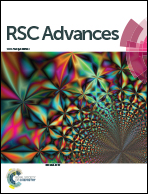Facile synthesis of BiOI/CdWO4 p–n junctions: enhanced photocatalytic activities and photoelectrochemistry†
Abstract
In this work, a series of novel BiOI/CdWO4 p–n junction photocatalysts were successfully fabricated via a facile ultrasonic and stirring process. The photodegradation tests showed that the BiOI/CdWO4 p–n junction photocatalysts show enhanced efficiencies compared to pure BiOI and CdWO4. The best photocatalytic performance was obtained for the BC-2.0 sample, and the as prepared samples were studied by XRD, TEM, HRTEM, XPS, UV-vis DRS and photoluminescence (PL) spectroscopy. This enhancement may be predominantly attributed to the improvement of the photogenerated electron–hole separation and migration efficiency of the synergy impact between BiOI and CdWO4. The efficient separation of electron–hole pairs because of the synergy impact between BiOI and CdWO4. Radical scavenger experiments and ESR indicated that holes (h+) and superoxide radicals (˙O2−) were the main active species in the photocatalytic process.


 Please wait while we load your content...
Please wait while we load your content...